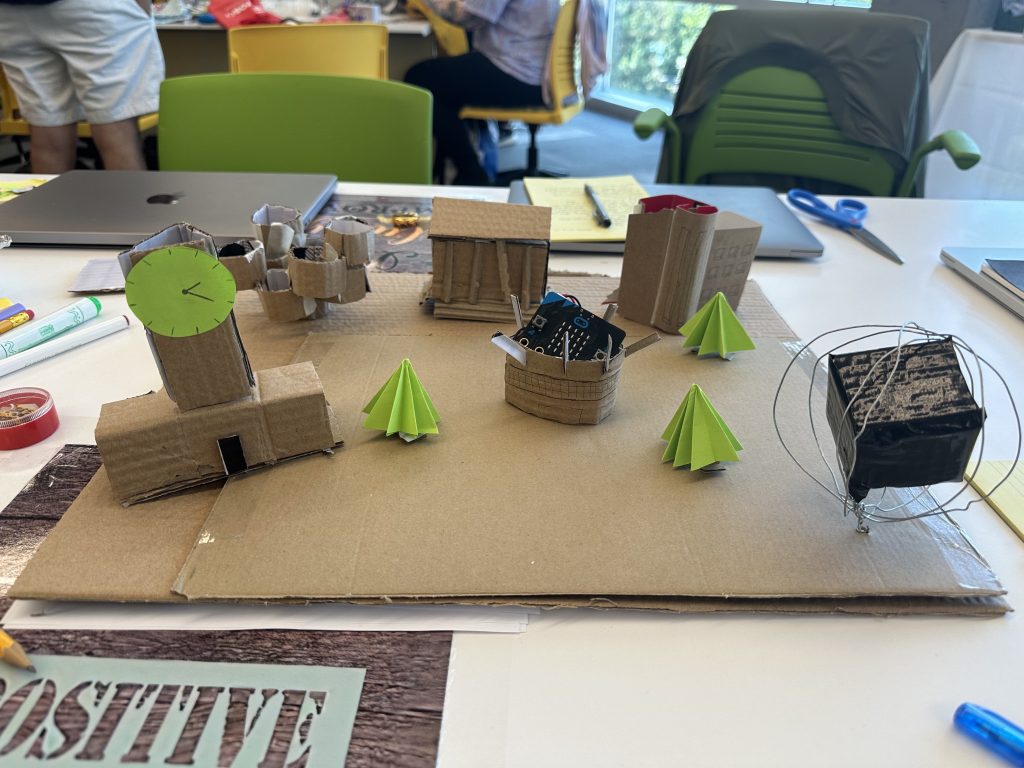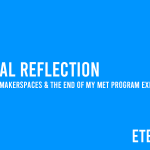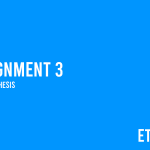MAKER CHALLENGE 1 – CARDBOARD TINY CITY

Instruction: The objective of this challenge is to utilize ordinary cardboard to create extraordinary items to solve real-world problems.
REFLECTION
Our group created a futuristic Vancouver using cardboard (and some paper). Although we only were able to start with the major landmarks, our goal would be to create a city that features accessible and inclusive features. Furthermore, the problem we would like to tackle would be Vancouver’s growing homeless population. As housing prices and inflation continue to increase, more Vancouverites will be forced to live in conditions which they may not be prepared for.
We started by picking major landmarks and then began making them out of cardboard. We included BC Place, the Vancouver Art Gallery, a ‘new’ Science World, and City Hall. Warren created a pod system for housing that really helped out model turn into a futuristic version of Vancouver.
In a perfect world, this model would be larger to include more areas of Vancouver instead of only the landmarks. That way, we would be able to showcase the model to stakeholders in the municipal and provincial government as a way to showcase possible changes and goals that could be considered. Having a tangible item that could be viewed (and essentially cannot be closed or ignored like in a digital form), can further help instigate change. An obvious barrier could be that it is difficult to plan for the future, and many could say that a model is only an ideal case scenario. Furthermore, the solving of the problem of homelessness around the world is an incredibly difficult problem (if it wasn’t, it would be solved already!). Some may say that more money should be allocated to help build affordable housing, but the money would need to come from another program in order to really make a difference. There would most likely be some apprehension if the province announced that they would take funding from the “Education” budget and move it towards solving this problem.
In essence, there is no clear way to solve the problem. Our model features a housing system that consists of pods which would allow for more housing in closer quarters. These pods could be build quite high, and could branch out over roads in order to not interfere with the road infrastructure. This is a possible solution to adding more housing options in Vancouver, but still must be done using funds from somewhere.
The next steps to our challenge would be filling in the rest of the city, and ideally using a base that represents the Greater Vancouver Area (maybe a map glued to the bottom cardboard). We also would like to expand upon the Pod system, to further showcase how it could be used to create housing while not impacting the road infrastructure.
MAKER CHALLENGE 2 – PUZZLE PIECES

Field Trip! – MakerLabs Vancouver
REFLECTION
Reflecting back on my experience at the MakerLab, I was absolutely amazed by the space itself. It felt like a place for exploration without any judgement. I felt really inspired seeing the members in the space as they worked on their own passion projects. The sense of passion behind each person that we met was evident, and helped to create a welcoming and inclusive experience.
For my puzzle piece, I decided to go with a mountain landscape with a snow-filled dark sky. I stuck with a white and black theme to emphasize the simplicity of who we all are, but included a gradient sky of purple to express the complications and mixed history we all have.
The gradient also symbolizes a change in our thinking as makers along the path to truth and reconciliation. We may come from a past with dark memories and events that we are ashamed of, but we there is hope to change ourselves for the better. The mountains in the puzzle piece are at a distance with hills in front to symbolize how our path we will encounter times where we will need to learn things that may be difficult for us or make us uncomfortable. We need to go through this path, and the path will not be flat. The trees also symbolize some areas which we will need to overcome as a society to help Indigenous people along the path. Overall, we need to walk through this path together, as we cannot survive it walking alone. The puzzle piece activity also felt like it aligned well with the First Peoples Principles of Learning, as the learning we experienced required patience and time (First Nations Education Steering Committee, n.d.). Taking the time to paint our puzzle pieces and really connect with the activity in a reflective way is what made the experience valuable for me.
Overall, my experience at the MakerLab was an extremely positive experience. It also gave me an opportunity to learn more about my peers and their own journey through the MET Program and in their professional fields. I was so impressed by the MakerLab, that I discussed the possibility of brining my school’s Grade 7 Class there on a field trip as an extension of S.T.E.M.
Ah ha! Moment: I first struggled to see how I would connect the First Peoples Principles of Learning to the Maker Lab field trip. It was obvious that the idea of making and using our natural resources would fit (especially the mentality of only using what is needed). However, when we were all sitting and painting is when they all started to align for me.
References First Nations Education Steering Committee. (n.d.). First Peoples Principles of Learning. https://www.fnesc.ca/first-peoples-principles-of-learning/
MAKER CHALLENGE 3 – GOOSECHASE

Running Around UBC!
REFLECTION
The introduction activity for our in-person time of ETEC565S was a blast! On the Goosechase app, we were given the opportunity to complete five tasks.
Credo & Mission Statement
We were tasked to create the ground rules for our group to ensure we feel comfortable and welcomed during our time together. This code of conduct was actually difficult for us to make although it is short, and it aligned really well with the readings we completed for CLT #2. I believe it is so important to make everyone feel welcomed and wanted in every environment, not just in learning. People need to feel safe and feel like they have the ability to be themselves. When others are too worried about not being themselves or hiding who they are, they cannot feel safe sharing their own knowledge or experiences with others. This tied into Melo’s research, as they shared the findings of how women do not feel as comfortable in makerspaces as men do due to not feeling comfortable with some technologies that would be labeled as “male”. Although the idea from Melo is shared specifically involving makerspaces, it should be considered and applied to all aspects of life.
Ah ha! Moment: This moment came after my maker week in ETEC 565S, but this connection really stuck with me. While watching the Barbie movie, I believe it did an excellent job in showcasing the issues that women face throughout all of society and it caused me to reflect back on the readings we conducted for CLT #2. It further emphasized the importance of ensuring that our entire world is welcoming to all and provides equal opportunities.
How do you define success and failure?
For this challenge, we decided to showcase how success can show in so many different forms. We followed 3 “students” who were trying to make a paper crane. One person was a master, and was able to complete multiple cranes. Another was struggling with a few crumbled pieces of paper, but was eventually able to make something that resembled a crane (kind of). The other simply sat there the entire time and did not touch their paper. The purpose of this is that any progress towards a goal should be considered as success. The person making multiple cranes has obviously achieve success, but so has the person who tried to make the crane. They were still able to make something, and should therefore celebrate that success as a step on the journey to their goal. The only person who technically shows failure is the person who refuses to engage with the activity or try. The act of making attempts to work towards a goal should be seen as success, and it is an important message that I will continue to share with my students.
Spell It Out!
This challenge was a lot of fun and allowed us to warm up our maker mentality! We needed to create the word “Makerspace” in an original way, so we decided to create it using objects and nature that already existed in the environment of UBC. As an example, the benches in the photo above could be used to make an “E” or “M”. This helped our group prepare our minds to look at objects and tasks more creatively, and not keep our mind confined in a box. I know for myself during times when I am teaching, my mind is often closed and not exactly in a very creative space. This activity helped me train my mind to think more creatively throughout the week, and was very valuable for an introduction activity!
Treasure Hunt
The final challenge that we had time to complete was the treasure hunt. For this challenge, we were tasked with finding materials in nature that could meaningfully be used in maker activities. We were actually able to use these materials for our Unit of Learning presentation at the end of our maker week, as they were available for our peers to use to create their comfort object. The materials were all then given back to nature to allow for another person to use them if needed. This activity aligned with the EDIDA Framework in a few ways, but the main way it connected for me was through the lens of diversity. Although each object comes from nature, it can mean different things to different cultures. Furthermore, these basic materials can also be used to create objects that hold great significance in different cultures. I thought this challenge did a great job in allowing us to think and share what these materials could mean to one another. It also could provide an opportunity for others to use the materials to explore cultures through making, such as the weaving of baskets or carving of wood.
I really enjoyed going on this Goosechase with my peers, and will see if I this app could be used with my class or summer camp group. This challenge was yet another example of something I have been able to take away from my experience in ETEC 565S and hopefully apply to my journey as an educator!






